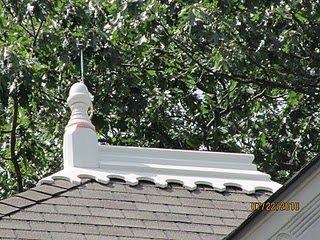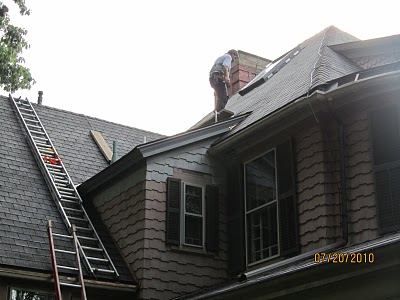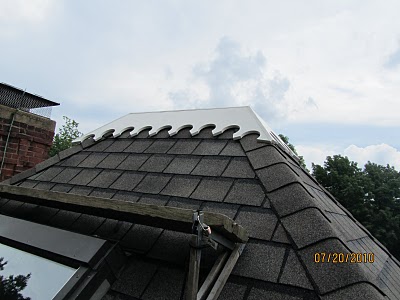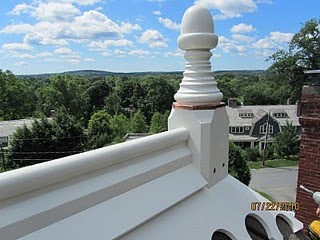Replacing An Acorn Roof Finial
By Robert Robillard on Finish Carpentry

This past winter we were asked to duplicate an old acorn finial that sat atop of a beautiful Victorian on Nashawtuc Road in Concord, Massachusetts. The roof was being redone and the old finial was over a hundred years old and in need of replacement.
The acorn roof finial mounts to the roof peak just behind the chimney pictured below.

Accessing the roof top was a problem. The roof peak is three stories up and at the top of a very steep pitched roof. We needed roof staging to safely traverse this terrain.

Almost there. Roof brackets pave a narrow path for access.

If you remember or looked at the previous posts you know that I choose to use Azek pvc for the scroll work on the roof.
I also used the Cortex concealled fastening system to hide all of the screw holes. This system drives a special screw into the Azek creating a perfectly sized countersunk hole.
A cortex pvc plug then fills the hole. The beauty of the cortex plug is that it is made from the same pvc material and will expand and contract at the same rate.
The plan was to assemble the scroll trim work on the ground, plug the holes, and then drop it in place over the roof peak and secure it to the roof. My thoughts were the least amount of time spent on the roof the better.
The new acorn finial and the old roof scroll work share a moment.

Dry fitting the acorn finial on the ground.
At the ridge we removed the ridge cap shingles and installed a thin layer of rubber as a redundancy weather protection layer. The scroll work will cover this area.

Scroll work in place and ready to install to the roof. Six stainless steel screws
were used to fasten it to the roof.

Fitting the acorn’s “tail” trim. Six stainless steel screws and adhesive secure the tail to the scroll trim.

Dry fitting and checking the acorn finial for plum. Nice view huh?

six holes were counter sunk into the acorn finial. I used 8″
timber lock screws to secure the acorn finial to the ridge beam and hip rafters.

The tail was then assembled and secured to the roof and also the acorn finial with two countersunk screws.

The acorn finial is made out of Spanish Cedar. We used the same material plugs hide the timber lock screws. These were sanded and primed before one final finish coat of paint.
Driveway view of the acorn finial.
Front yard view.

Close up view before the final coat of paint.

The lightening rod protection was reinstalled. [green rod / point seen behind the acorn head]










